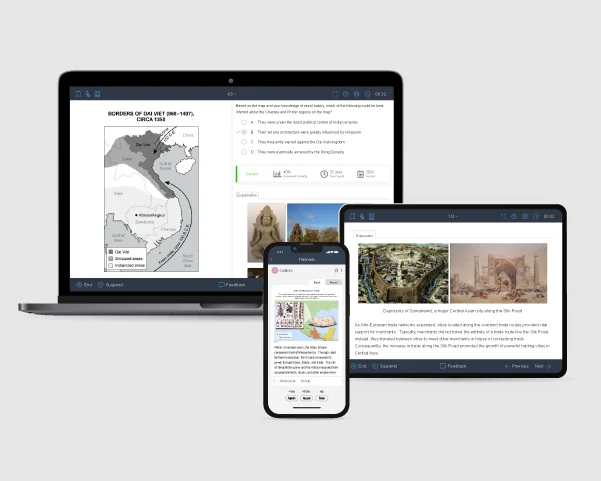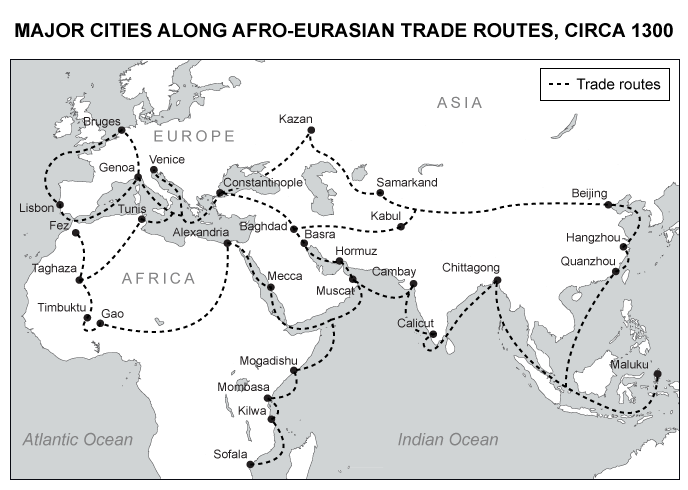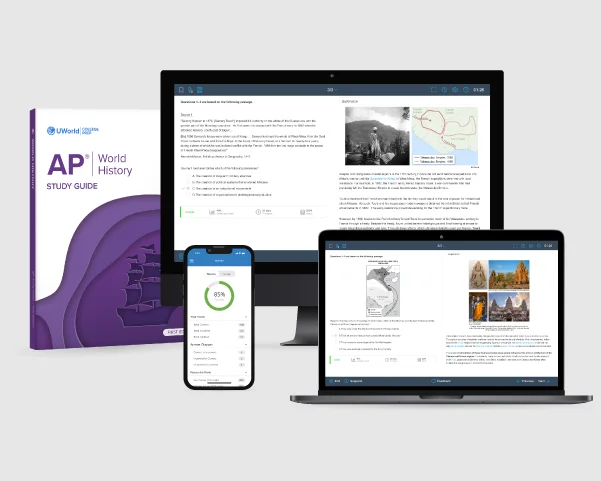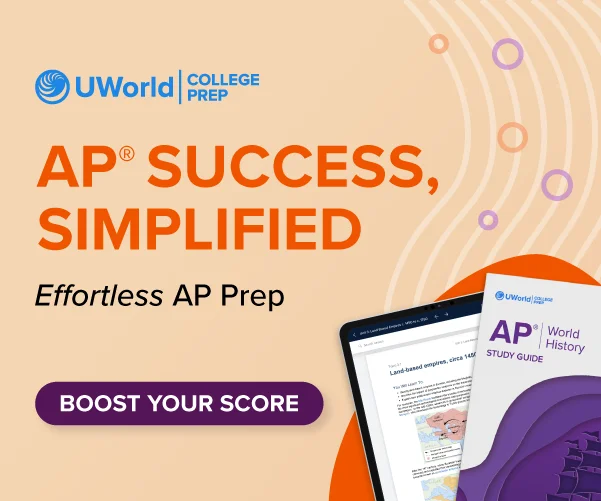Format of AP World History MCQ section
On the AP World History exam, there are 55 multiple-choice questions. You will be given 55 minutes to complete this section of the test, and it counts for 45% of the exam score. Each question is weighted the same and can be from any of the nine units in the course. The table below is a summary of how each unit is weighted in this section.
| Units | Topics | Exam Weighting |
|---|---|---|
| Unit 1 | The Global Tapestry | 8-10% |
| Unit 2 | Networks of Exchange | 8-10% |
| Unit 3 | Land-Based Empires | 12-15% |
| Unit 4 | Transoceanic | 12-15% |
| Unit 5 | Revolutions | 12-15% |
| Unit 6 | Consequence of Industrialization | 12-15% |
| Unit 7 | Global Conflict | 8-10% |
| Unit 8 | Cold War and Decolonization | 8-10% |
| Unit 9 | Globalization | 8-10% |
How to Approach AP World History’s Multiple-Choice Questions?
For many students, the AP World History MCQ section can be the most difficult section of the test because you must answer 55 stimulus-based questions within 55 minutes. That is one question a minute! It can be a challenge to understand the selections and pick the right answers in that amount of time. Here are some tips to help you prepare for the difficulty of the questions and work quickly.
-
Read the question first.
Because you have to answer all the AP World History multiple-choice questions, you can’t afford to waste time trying to understand everything about the stimulus. Instead, a good strategy is to read the question and then examine the stimulus for information that will help you choose the correct answer. The question will give you the context in which to interpret the stimulus and make it easier to locate relevant information quickly.
-
Annotate as you read or examine the stimulus.
Make notes on the scratch paper while you read or examine the stimulus. For example, you might call attention to word usage, patterns in data, or the point of view of political cartoons. You may also want to make notes on the historical context of the stimulus.
-
All parts of an answer must be accurate for the answer to be correct; partly right isn't close enough.
Sometimes students are fooled into thinking an answer is correct because part of the answer choice is right. However, the rest of the answer may contain inaccurate information that makes the entire answer wrong. For example, eliminate answers that have historical inaccuracies or are beyond the time frame defined by the question.
-
If you can't determine the right answer, focus on finding what makes each answer choice wrong instead.
Eliminating obviously wrong answers will help you narrow down the choices and make a better guess, if necessary.
-
Answer every question.
There is no penalty on the exam for incorrect answers, so you should always take your best guess at answers because the odds are better if you record an answer for every question.

AP World History multiple-choice examples
Here are a few AP World History practice questions:
Passage
"Fellow countrymen and women, you, the people of Eastern Nigeria:
Conscious of the supreme authority of Almighty God over all mankind, of your duty to yourselves and posterity;
Aware that you can no longer be protected in your lives and in your property by any Government based outside Eastern Nigeria;
Believing that you are born free and have certain inalienable rights which can best be preserved by yourselves;
Unwilling to be unfree partners in any association of a political or economical nature;
Rejecting the authority of any person or persons other than the Military Government of Eastern Nigeria to make any imposition of whatever kind or nature upon you;
Determined to dissolve all political and other ties between you and the former Federal Republic of Nigeria;
Prepared to enter into such association, treaty or alliance with any sovereign state within the former Federal Republic of Nigeria and elsewhere on such terms and conditions as best to subserve your common good;
Affirming your trust and confidence in me;
Having mandated me to proclaim on your behalf, and in your name, that Eastern Nigeria be a sovereign independent Republic,
Now, therefore, I, Lieutenant-Colonel Chukwuemeka Odumegwu Ojukwu, Military Governor of Eastern Nigeria, by virtue of the authority, and pursuant to the principles, recited above, do hereby solemnly proclaim that the territory and region known as and called Eastern Nigeria together with her continental shelf and territorial waters shall henceforth be an independent sovereign state of the name and title of 'The Republic of Biafra.'"
– Chukwuemeka Ojukwu, governor of Eastern Nigeria, Biafra's Declaration of Independence, 1967
MCQ
The passage above is best understood in the context of which of the following?
- African governors' continued use of religion to create independent states
- The influence of the United States political system in Nigeria after the Second World War
- The expansion of the British Empire in West Africa
- The differential treatment of Muslims and Hindus in Nigeria
Correct Answer: C
This type of MCQ on the AP World History exam asks you to place the stimulus in a broader historical context. For these kinds of questions, it is helpful to consider the historical period and processes surrounding the events portrayed in the stimulus
Passage
"Fellow countrymen and women, you, the people of Eastern Nigeria:
Conscious of the supreme authority of Almighty God over all mankind, of your duty to yourselves and posterity;
Aware that you can no longer be protected in your lives and in your property by any Government based outside Eastern Nigeria;
Believing that you are born free and have certain inalienable rights which can best be preserved by yourselves;
Unwilling to be unfree partners in any association of a political or economical nature;
Rejecting the authority of any person or persons other than the Military Government of Eastern Nigeria to make any imposition of whatever kind or nature upon you;
Determined to dissolve all political and other ties between you and the former Federal Republic of Nigeria;
Prepared to enter into such association, treaty or alliance with any sovereign state within the former Federal Republic of Nigeria and elsewhere on such terms and conditions as best to subserve your common good;
Affirming your trust and confidence in me;
Having mandated me to proclaim on your behalf, and in your name, that Eastern Nigeria be a sovereign independent Republic,
Now, therefore, I, Lieutenant-Colonel Chukwuemeka Odumegwu Ojukwu, Military Governor of Eastern Nigeria, by virtue of the authority, and pursuant to the principles, recited above, do hereby solemnly proclaim that the territory and region known as and called Eastern Nigeria together with her continental shelf and territorial waters shall henceforth be an independent sovereign state of the name and title of 'The Republic of Biafra.'"
– Chukwuemeka Ojukwu, governor of Eastern Nigeria, Biafra's Declaration of Independence, 1967
MCQ
Which of the following events would have been most likely to produce a political context similar to the one depicted in the passage?
- The spread of anti-imperialist ideas
- The Bangladesh Liberation War in East Pakistan
- The anti-apartheid movement
- The unification of Italy
Correct Answer: B
Another common type of MCQ on the AP World History exam asks about the similarities between different historical events, processes, or developments. You must consider both the historical context and effect of the stimulus along with the answer choice to determine the correct answer.
Passage
The following two excerpts are from the Spanish conquistador Bernal Díaz's The Discovery And Conquest Of Mexico 1517-1521.
Introduction
"The Mexicans or Aztecs were a people of Nahua race who, after many years of wandering on their way from the North, finally settled in the high plain or valley, which still retains their name….By their own warlike prowess and diplomatic alliances with neighboring towns they gradually increased in power until they gained the hegemony of the tribes and peoples of the valley, and then carried their warlike enterprises into distant parts of the country, even as far as Tabasco and Guatemala. They became the head of a military and predatory empire, dependent for their food, as well as their wealth, on tribute drawn from subject tribes and races."
Chapter LXV
“When we arrived at the great market place…we were astounded at the number of people and the quantity of merchandise that it contained, and at the good order and control that was maintained, for we had never seen such a thing before…. Each kind of merchandise was kept by itself and had its fixed place marked out. Let us begin with the dealers in gold, silver, and precious stones, feathers, mantles, and embroidered goods. Then there were other wares consisting of Indian slaves both men and women….Next there were other traders who sold great pieces of cloth and cotton, and articles of twisted thread, and there [they]…sold cacao…. Sweet cooked roots, and other tubers which they get from this plant, all were kept in one part of the market in the place assigned to them."
MCQ
Which of the following would be most useful in establishing the reliability of Bernal Díaz's depiction of the marketplace in the passage?
- An account by Bernal Díaz who witnessed a market in Peru
- An account of the tribute paid by various tribes to the Spanish king
- An account by Aztec tax officials of the goods sold in the marketplace
- An account from a modern-day history of the Spanish conquistadors
Correct Answer: C
Sometimes an AP World History MCQ asks you to think critically about primary sources. Questions that do this may ask what specific piece of historical evidence would corroborate a given first-hand account. For example, the correct answer to the question above is the piece of evidence that most strongly supports the account given in the passage-based stimulus.
Passage

MCQ
Which of the following was an important continuity in long-distance trade from 1200 to 1450?
- The Byzantine Empire controlled major cities along the Mediterranean
- Europeans produced most of the world's luxury products
- Trade depended on environmental knowledge
- Reliance on ships for the transport of bulk goods declined
Correct Answer: C
Multiple choice questions come from a map-based stimulus and may ask about historical process of change and continuity over time. It is important that you consider both the date on the map and any interactions it may reveal. In the example question above, the correct answer is the statement that is the most accurate give the historic period given and the elements shown on the map.
Passage
Source 1
"Señor: yesterday, Monday, which was the 27th of April, we went on shore*…and we took the height of the sun at midday; and we found 56 degrees, and the shadow was north. By according to the rules of the astrolabe, we judged that we were 17 degrees distant from the equinoctial and consequently had the height of the Antarctic pole in 17 degrees, as is manifest in the sphere….
"Letter from João Faras, Spanish astronomer and physician to King Manuel of Portugal, May 1500
Source 2
And thus [Pedro Álvares Cabral] went his way to make port at the kingdom of [Kilwa], which belongs to the Moors, under whose sovereignty is the said mine of [Sofala], because he carried my letters and messages for its king, to establish peace with him, and a treaty concerning purchases and trade at the said mine…. He was very well received by that king…. [N]o trade was begun there at that time because the merchandise which the other ships carried was not suitable for what was needed for that land.**And he departed from there and went to another kingdom, Malindi…. This king likewise visited him on the sea and also sent him presents, and confirmed and established peace and friendship with him….
Letter from King Manuel of Portugal to the monarchs of Castile, July 1501
Passage Footnotes
- at present-day Porto Seguro, Brazil
- it is now understood that the real reason that negotiations failed was because Kilwa's leader hesitated
MCQ
Based on the activities in the excerpts and your knowledge of world history, which of the following can be inferred about the long-term effect of Portuguese transoceanic expeditions?
- They strengthened claims that the factory system produced lower quantities of goods than the putting-out system
- They created an opportunity for Southeast Asian states to develop their own spice trade network
- They provided Afro-Eurasians with nutritional benefits from American food crops
- They contributed to the expansion of Native American territories through treaties
Correct Answer: C
Many times, an AP World History MCQ asks you to bring in your knowledge of world history to infer the likely long-term effects of events and historical developments. Instead of thinking about the specifics of the stimulus, think about the historical development or process the stimulus represents. In the example above, you need to understand that the excerpt reflects the beginning of the Columbian Exchange, and therefore, the correct answer will be an outcome of this historical process.
How can I practice AP World History multiple-choice questions?
One of the best ways to improve your AP World History MCQ score is to practice by answering lots of questions. That way you become familiar with the kinds of information typically asked for and the language that is often used. It is a good idea at first to practice answering the questions at your own pace so you can think carefully about the answers. After you have developed your confidence and skill, it is wise to practice answering the questions at a pace similar to what you will experience on the exam: about a minute per question.
An excellent source of AP World History MCQ practice is UWorld APWH prep course. It includes a QBank, which offers hundreds of exam-like MCQs with detailed explanations for both correct and incorrect answers, helping you learn from mistakes. In addition to the QBank, you also get an APWH study guide that provides comprehensive content coverage to support your preparation.
Frequently Asked Questions (FAQ)
How are AP World History multiple-choice questions graded?
Each question is equally weighted. You need to answer about 55% of the questions correctly in order to receive a passing score on this section of the APWH exam.
How long is the multiple-choice question section of the AP World History exam?
You are given 55 minutes to complete the MCQ section of the AP World History exam.
Where can I get the AP World History past exam multiple-choice questions?
The College Board does not typically make their MCQs from past exams available publicly. That is why a resource like UWorld is the best way to practice for that section of the exam.
References
(2025). Exam Components. AP World History: Modern. Retrieved on January 7, 2025 from https://apstudents.collegeboard.org/courses/ap-world-history-modern/assessment

Read More About the AP World History Exam
Learn how to handle free-response questions with UWorld. Get sample FRQs, AP World History study tips, and essential strategies to do your best in this section!
How to Write AP World History Modern Short Answer QuestionsUnderstand how to write AP World History: Modern short-answer questions with ease using this step-by-step guide. Master key tips and strategies to earn full points!
AP World History Study Plan and TipsAchieve your desired score to get into dream school with UWorld! Explore our AP World History expert guide, packed with tips, tricks, and resources to ace the exam.
Best AP World History Prep Course ReviewFind the top AP World History prep courses with engaging lessons, practice tests, and expert tips to help you master the exam and secure your college admissions.
AP World History Study Guide ComparisonCompare the top AP World History study guides to find the best resources, including reviews, practice questions, detailed explanations to help you excel on APWH.
How to Self-Study for AP World HistorySelf-study for AP World History like a pro with our guide featuring personalized tips, essential materials, and proven methods to prepare confidently for your APWH exam.




